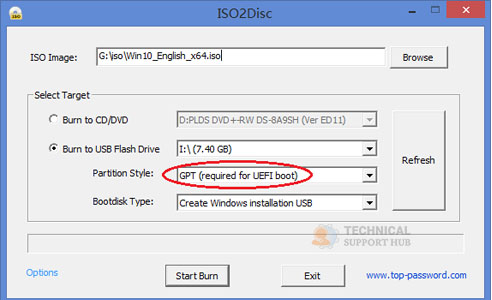
- #Burn iso image to usb drive windows 10 how to
- #Burn iso image to usb drive windows 10 install
- #Burn iso image to usb drive windows 10 for windows 10
It also allows you to create UEFI or legacy bootable USB installation drive from Windows 10 ISO image. Of course, there are also some other USB creation tools available on the net, such as Rufus. After creating, you’ll find out that a UEFI bootable USB drive was formatted as FAT32 because NTFS is not supported for external boot media under UEFI. It will now create a Windows 10 USB installer. Otherwise choose “ MBR (for legacy BIOS / CSM boot)” for BIOS-based PC, or UEFI computer running in legacy BIOS/CSM mode.
#Burn iso image to usb drive windows 10 install
If you want to install Windows 10 in UEFI mode on UEFI-based PC, choose the “ GPT (required for UEFI boot)” option.
#Burn iso image to usb drive windows 10 how to
We’re explaining how to create a Windows 10 USB installer, so click on “ Burn to USB Flash Drive” and select the drive letter of your USB disk from the list. Insert your USB drive into the computer and start ImgBurn program. After the burning process completes, copy and paste the burned ISO image file to USB drive.
#Burn iso image to usb drive windows 10 for windows 10
How to Create UEFI or Legacy Bootable USB Drive for Windows 10 Setup The stock tools on Windows 10 doesn’t support burning to a USB just yet but let’s give it ten years and it’s bound to catch up. Windows 10 ISO image, which can be downloaded from Microsoft’s website using its Media Creation Tool.A USB drive (a microSD, SD card or memory stick) with the minimum capacity 4 GB.In this tutorial we’ll explain how you can easily create a UEFI or legacy bootable USB drive for Windows 10 Setup. Luckily, for backward compatibility most of the UEFI systems can also be configured to disable UEFI secure boot and instead revert to legacy BIOS boot mode. UEFI-based computer can only boot from GPT-partitioned USB drive. As you probably noticed when using a MBR-partitioned Windows installation USB drive on a new Windows 10 PC, UEFI will not recognize it as a boot media.

New Windows 10 computers use UEFI firmware instead of the traditional BIOS.


 0 kommentar(er)
0 kommentar(er)
